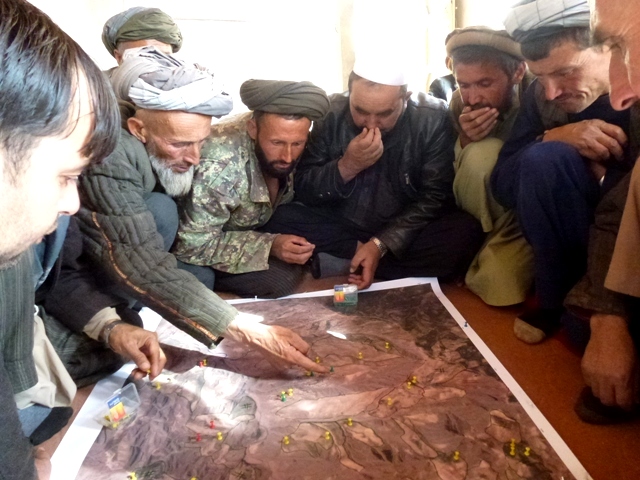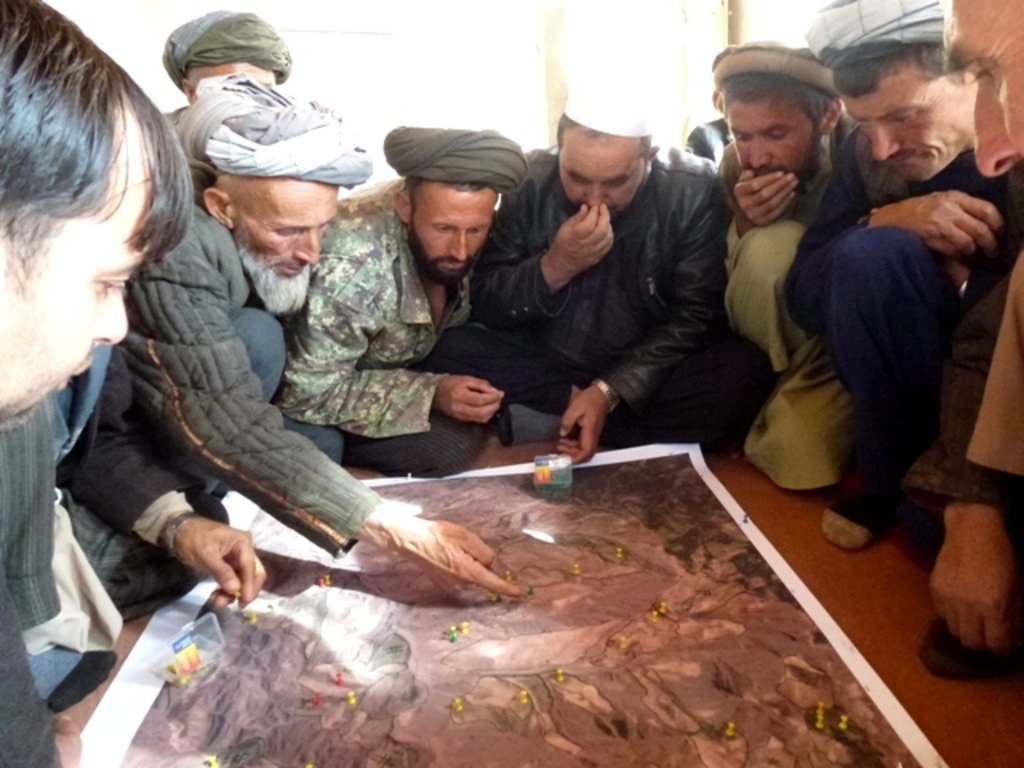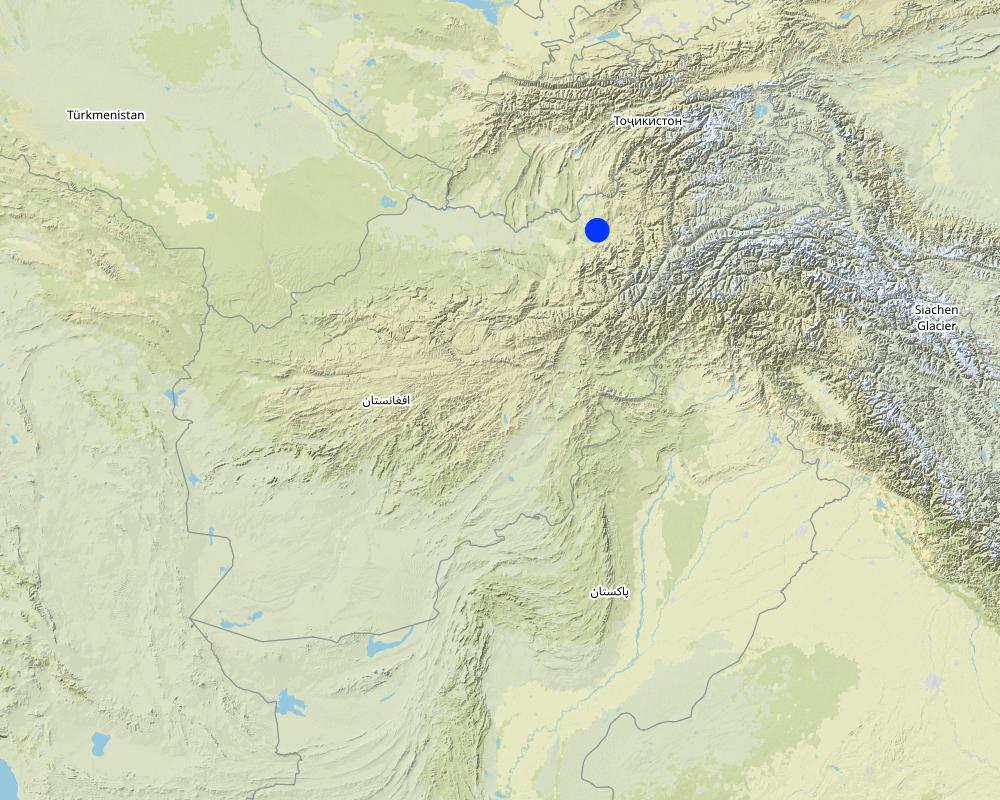Watershed Associations (WSA) and Natural Resource Management Committees (NRMC) [Afghanistan]
- Creation:
- Update:
- Compiler: Bettina Wolfgramm
- Editors: Roziya Kirgizbekova, Aqila Haidery
- Reviewer: William Critchley
approaches_545 - Afghanistan
View sections
Expand all Collapse all1. General information
1.2 Contact details of resource persons and institutions involved in the assessment and documentation of the Approach
Name of project which facilitated the documentation/ evaluation of the Approach (if relevant)
Potential and limitations for improved natural resource management (NRM) in mountain communities in the Rustaq district, Afghanistan (Rustaq NRM Study)Name of the institution(s) which facilitated the documentation/ evaluation of the Approach (if relevant)
Terre des Hommes (Terre des Hommes) - SwitzerlandName of the institution(s) which facilitated the documentation/ evaluation of the Approach (if relevant)
CDE Centre for Development and Environment (CDE Centre for Development and Environment) - Switzerland1.3 Conditions regarding the use of data documented through WOCAT
When were the data compiled (in the field)?
17/10/2016
The compiler and key resource person(s) accept the conditions regarding the use of data documented through WOCAT:
Yes
1.4 Reference(s) to Questionnaire(s) on SLM Technologies
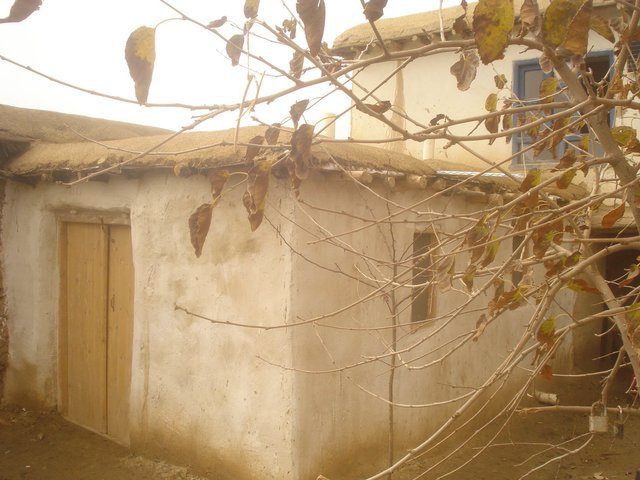
Improved livestock shed for better health and productivity [Afghanistan]
Existing livestock sheds can be improved through interior and exterior refurbishing, and door and window installation. More favourable indoor conditions benefit animal health and the quality of animal products.
- Compiler: Bettina Wolfgramm
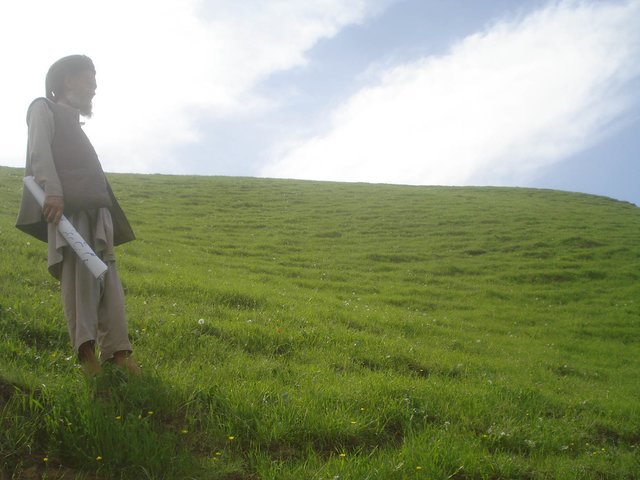
Rotational grazing to restore degraded pastures [Afghanistan]
A plan for rotational grazing has been developed to control pasture use and prevent overgrazing of rehabilitated pastures.
- Compiler: Bettina Wolfgramm
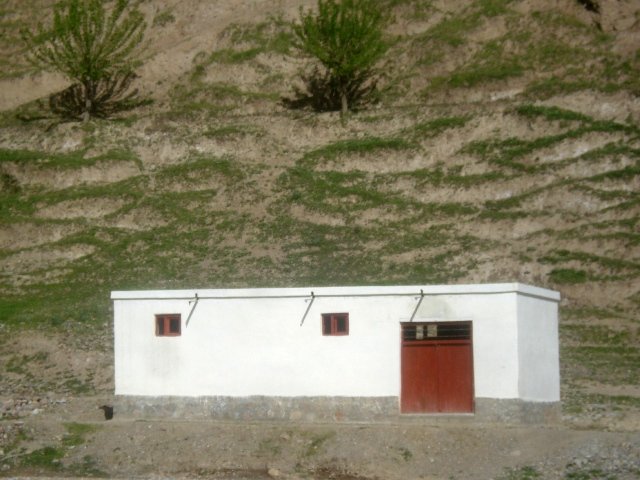
Community fodder bank for sustaining supplies [Afghanistan]
Community fodder banks have been established in villages for the purpose of ensuring supplies of livestock fodder during winter, to prevent loss of livestock and to prevent over-grazing early in spring.
- Compiler: Bettina Wolfgramm
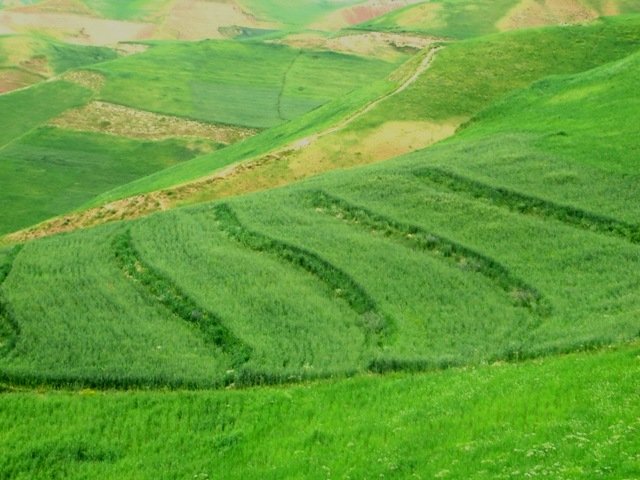
Terraces with improved seed and fertilizer application [Afghanistan]
Terraces are established on mountain slopes used mainly for cropping wheat, with the purpose of soil protection from erosion, preserving runoff, sediments and nutrients on-site. Improved seeds and fertilizer are applied on the terraces for increasing crop yield, but also vegetation cover and biomass production, and thus prevent further land …
- Compiler: Roziya Kirgizbekova
2. Description of the SLM Approach
2.1 Short description of the Approach
Two Watershed Associations (WSA), in Chaker and Nahristan watershed areas respectively, are registered at the national level with the Ministry of Agriculture Irrigation and Livestock (MAIL) and at the regional level with the Department of Agriculture. Both associations are strong, active, dynamic, and have the capacity to coordinate and support the Natural Resource Management Committees (NRMC) at village level.
2.2 Detailed description of the Approach
Detailed description of the Approach:
Terre des Hommes (Tdh) has been implementing the Livelihood project (LIPT) in Rustaq district in northern Afghanistan since 2007. The overall aim of the project is to offer the rural population new and improved livelihood options, with capacity building of the rural population, to design and implement their own sustainable development options, and to enhance their resilience to cope with natural and conflict-related stress. For this purpose, capacity of supporting stakeholder institutions is strengthened (LIPT’s boundary partners) to ensure that good development is on-going. Boundary partners are trained and equipped in relevant techniques regarding sustainable natural resource management.
Two Watershed Associations (WSA) and 20 Natural Resources Management Committees (NRMC) were founded through LIPT. Two WSAs, in Chaker and Nahristan watershed areas, are registered at national level within the Ministry of Agriculture Irrigation and Livestock (MAIL), and at the regional level with the Department of Agriculture. Both associations are strong, active, dynamic, and have the capacity to coordinate and support the NRMCs at village level. Out of their newly established and registered regional offices, the WSAs coordinate the NRMCs, take over responsibilities from Tdh (e.g. the 2014 reforestation campaign) and are getting more involved in planning and monitoring of LIPT’s activities. The 20 NRMCs have "hands and eyes" on all LIPT activities implemented in their communities, and their trained extension workers render valuable services to the farmers in their villages.
Methods: Today, all NRMCs have a strong institutional set-up. Their extension workers have been trained and equipped. Members of NRMCs and WSAs have been trained on group management, planning, documentations, record keeping, IPM, reforestation management, soil protection, mulching, hedgerows and terracing, making fermenters, pruning and budding. WSAs and NRMCs gained further organizational, technical and management capacity building in both watershed areas. As one of biggest challenge at watershed level is soil erosion within hillside agriculture, LIPT III trained the NRMCs and WSAs on terracing and hedgerows to protect the soil from erosion. Furthermore, NRMCs were trained in sustainable irrigation water management, gully treatment, and surface water harvesting. There were also training courses conducted on leadership, finance, proposal writing, documentation, procurement and operations management.
Both WSAs and NRMCs started to get a real understanding of environmental issues and were then able to motivate their communities. WSAs coordinated the NRM intervention with NRMCs including reforestation, soil protection hedgerows, contour lines, terracing, establishment of public nurseries (to produce trees and be an income source for WSAs), establishment of centralized community bakeries (to reduce the demand for firewood and decrease the women’s workload in the watershed areas), irrigation infrastructure, bio-engineering and gully control (to reduce the progression of gullies on both ploughed lands and pastures), livestock value chains at regional (watershed) level, etc., while NRMCs are looking after these interventions and the mobilization of the community at the village level. Farmers and communities have adopted natural resource management practices to maintain/increase soil fertility, rangeland, water resources and forest coverage.
2.3 Photos of the Approach
2.5 Country/ region/ locations where the Approach has been applied
Country:
Afghanistan
Region/ State/ Province:
Tahor Province, Rustaq districts
Further specification of location:
Dashti Mirzai, Javaz Khana and Sari Joy villages
Map
×2.6 Dates of initiation and termination of the Approach
Indicate year of initiation:
2007
If precise year is not known, indicate approximate date when the Approach was initiated:
less than 10 years ago (recently)
2.7 Type of Approach
- project/ programme based
2.8 Main aims/ objectives of the Approach
The main aim of the project is to offer the rural population new and improved livelihood options and to deliver capacity building for the rural population to design and implement their own sustainable development options and enhance their resilience to cope with natural and conflict related stress.
2.9 Conditions enabling or hindering implementation of the Technology/ Technologies applied under the Approach
social/ cultural/ religious norms and values
- enabling
The functions of men and women are clearly distinguished within Afghan society, while at the same time within the family this division of work and functions also results in men and women working hand-in-hand. An improvement of the family’s livelihood situation is expected to positively affect all family members. However. it is recognized that the involvement of women is key in order to secure basic human rights for everyone, to achieve good governance, sustainable development, and to efficiently contribute to poverty reduction (SDC 2004), it is also clear that a context sensitive approach is of high importance.
- hindering
Lack of capacity of the rural population to design and implement sustainable development options; vulnerability to natural and conflict related stress
institutional setting
- enabling
Establishment of Watershed Associations (WSA) and Natural Resources Management Committees (NRMC)
- hindering
Lack of institutions at the community level to introduce natural resource management options
knowledge about SLM, access to technical support
- enabling
Training has improved technical knowledge
- hindering
Lack of technical knowledge
3. Participation and roles of stakeholders involved
3.1 Stakeholders involved in the Approach and their roles
- local land users/ local communities
The overall aim of the project is to offer the rural population new and improved livelihood options and give capacity building to the rural population to design and implement their own sustainable development options, and enhance their resilience to cope with natural and conflict related stress.
- community-based organizations
Watershed Associations (WSA) and Natural Resources Management Committees (NRMC)
- international organization
Terre des Hommes , SDC
3.2 Involvement of local land users/ local communities in the different phases of the Approach
| Involvement of local land users/ local communities | Specify who was involved and describe activities | |
|---|---|---|
| initiation/ motivation | none | |
| planning | interactive | |
| implementation | interactive | |
| monitoring/ evaluation | interactive |
3.4 Decision-making on the selection of SLM Technology/ Technologies
Specify who decided on the selection of the Technology/ Technologies to be implemented:
- all relevant actors, as part of a participatory approach
4. Technical support, capacity building, and knowledge management
4.1 Capacity building/ training
Was training provided to land users/ other stakeholders?
Yes
Specify who was trained:
- land users
- field staff/ advisers
4.2 Advisory service
Do land users have access to an advisory service?
Yes
Specify whether advisory service is provided:
- on land users' fields
4.3 Institution strengthening (organizational development)
Have institutions been established or strengthened through the Approach?
- yes, moderately
Specify the level(s) at which institutions have been strengthened or established:
- local
- regional
- national
Describe institution, roles and responsibilities, members, etc.
LIPT III will leave behind successful and strong boundary partners in place to carry out the development options, as main boundary partners (WSAs, NRMCs, as the major boundary partners) will have a source of income for their operation and management.
Specify type of support:
- financial
- capacity building/ training
- equipment
4.4 Monitoring and evaluation
Is monitoring and evaluation part of the Approach?
Yes
4.5 Research
Was research part of the Approach?
Yes
Specify topics:
- economics / marketing
- technology
Give further details and indicate who did the research:
On-going research, as well as multiple trials by LIPT to find the best-adapted technical solutions, to communicate and discuss them with local communities and farmers, were the key elements of this success.
5. Financing and external material support
5.1 Annual budget for the SLM component of the Approach
If precise annual budget is not known, indicate range:
- 10,000-100,000
5.2 Financial/ material support provided to land users
Did land users receive financial/ material support for implementing the Technology/ Technologies?
Yes
If yes, specify type(s) of support, conditions, and provider(s):
Fully supported under project
5.4 Credit
Was credit provided under the Approach for SLM activities?
No
5.5 Other incentives or instruments
Were other incentives or instruments used to promote implementation of SLM Technologies?
Yes
If yes, specify:
local institution were support with equipment
6. Impact analysis and concluding statements
6.1 Impacts of the Approach
Did the Approach help land users to implement and maintain SLM Technologies?
- No
- Yes, little
- Yes, moderately
- Yes, greatly
NRM is the area where LIPT III made the most remarkable progress despite the fact that NRM was a completely new approach, and its implementation is highly demanding in terms of manpower, community awareness and mobilization. Profound changes in behaviour, motivation and mobilization both at individual and community levels made this possible. On-going research, as well as multiple trials by LIPT to find the best-adapted technical solutions, and to communicate and discuss them with local communities and farmers, were the key elements of this success. The NRMCs, WSAs as well as individual farmers in both watershed areas increased their knowledge and gained a better understanding of the importance of sustainable management, rehabilitation of farm land, pastures and their main natural resources. Farmers adapt and replicate the innovations once they see the results, farmers interest became high and they are ready to replicate it to protect their land form degradation.
Did the Approach improve knowledge and capacities of land users to implement SLM?
- No
- Yes, little
- Yes, moderately
- Yes, greatly
Farmers adapt and replicate the innovations. Once they see the results, farmers' interest became high and they are ready to replicate it to protect their land from degradation.
Did the Approach lead to employment, income opportunities?
- No
- Yes, little
- Yes, moderately
- Yes, greatly
One Example: Under irrigation water improvement interventions, LIPT in coordination with NRMCs brought more 110 ha land under irrigation and the yield is expected to be doubled in this agricultural land, and NRMCs are trained on sustainable irrigation water management, gully treatment, and surface water harvesting
6.2 Main motivation of land users to implement SLM
- increased production
- reduced land degradation
- reduced risk of disasters
6.3 Sustainability of Approach activities
Can the land users sustain what has been implemented through the Approach (without external support)?
- yes
If yes, describe how:
To look to the capacity and institutional strengthening of the project boundary partners, LIPT III will leave behind a successful and strong boundary partner in place to carry out the development options, as main boundary partners will have source of income (nurseries, cooperative shop, etc.) for their operation and management.
6.4 Strengths/ advantages of the Approach
| Strengths/ advantages/ opportunities in the land user’s view |
|---|
| The traditional social structures and customary institutions play an important role in problem solving in everyday community life, but traditional problem solving structures may also limit the taking up of new approaches. More effective approaches are needed, for example in the field of the management of common pool resources (water, pastures, trees and shrubs). The newly established Watershed Associations demonstrate how groups addressing specific urgent tasks may be successfully established and functioning within a very short period of time. |
|
NRM is the area where LIPT III made the most remarkable progress despite the fact that NRM was a completely new approach, and its implementation is highly demanding in terms of manpower, community awareness and mobilization. Profound changes in behaviour, motivation and mobilization both at individual and community levels made this possible. The permanent research, as well as multiple trials by LIPT to find the best-adapted technical solutions, to communicate and discuss them with local communities and farmers were the key elements of this success. WSAs and NRMCs are playing an active role in implementation of NRM intervention, even they have become more interested and active when they registered in Department of Agriculture Irrigation and Livestock at national and regional level. |
| Farmers adapt and replicate the innovations once they see the results, as soil erosion is the main concern in Rustaq - but nobody in watershed area was ready to protect their agriculture land by implementing barrier hedgerows. After demonstrating of hedgerow by LIPT III, farmers saw its impact on controlling of soil erosion, farmers' interest became high and they are ready to replicate it to protect their land from degradation. |
|
All community extension workers are trained and in place, playing an essential role in supporting the boundary partners in implementing NRM activities that include community mobilization, technical design of orchards and nurseries, reforestation sites, terracing and hedgerow designs. The NRMCs, WSAs as well as individual farmers in both watershed areas increased their knowledge and gained better understanding of the importance of sustainable management, rehabilitation of farmland, pastures and their main natural resources. A high degree of motivation and mobilization of farmers, and adequate technical capacity of CEWs regarding NRM is certainly one of the main outcomes of the LIPT, and an essential step towards the fulfilment of LIPT’s mission. |
| Strengths/ advantages/ opportunities in the compiler’s or other key resource person’s view |
|---|
| A rewarding sign of the development of NRM awareness is how farmers took up the problem of soil erosion.100 ha of cultivable land on hillsides have been terraced since the terracing activity had been initiated in November 2013. And 155 ha of additional land are in the process of being terraced. The biggest success with terracing is that a number of farmers started replication themselves what they had seen. |
7. References and links
7.1 Methods/ sources of information
- field visits, field surveys
- compilation from reports and other existing documentation
Links and modules
Expand all Collapse allLinks

Improved livestock shed for better health and productivity [Afghanistan]
Existing livestock sheds can be improved through interior and exterior refurbishing, and door and window installation. More favourable indoor conditions benefit animal health and the quality of animal products.
- Compiler: Bettina Wolfgramm

Rotational grazing to restore degraded pastures [Afghanistan]
A plan for rotational grazing has been developed to control pasture use and prevent overgrazing of rehabilitated pastures.
- Compiler: Bettina Wolfgramm

Community fodder bank for sustaining supplies [Afghanistan]
Community fodder banks have been established in villages for the purpose of ensuring supplies of livestock fodder during winter, to prevent loss of livestock and to prevent over-grazing early in spring.
- Compiler: Bettina Wolfgramm

Terraces with improved seed and fertilizer application [Afghanistan]
Terraces are established on mountain slopes used mainly for cropping wheat, with the purpose of soil protection from erosion, preserving runoff, sediments and nutrients on-site. Improved seeds and fertilizer are applied on the terraces for increasing crop yield, but also vegetation cover and biomass production, and thus prevent further land …
- Compiler: Roziya Kirgizbekova
Modules
No modules


